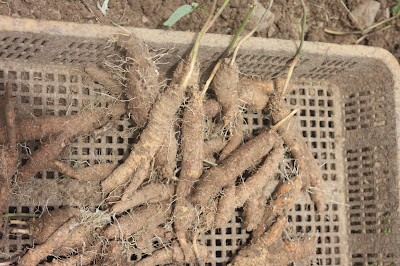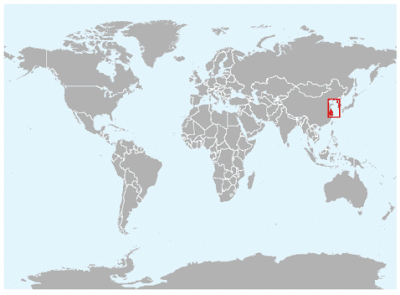The Korean Peninsula which are divided into 38 parallel is rich in varieties of plant life typical of temperate regions. More than 3,000 species, some 500 of them unique to Korea, have been noted by botanists. Warm temperate vegetation, including camellias and other broad-leaved evergreens, predominate in the south and on Jeju Island.
Zoologists have identified more than 130 freshwater fishes, 112 breeding birds, 49 mammals, and 14 reptiles and amphibians on the peninsula. Bear, wild boar, deer, and lynx still are found in the highlands, but the shrinking of the forested area has reduced the animal population in recent years. Migratory water fowl, cranes, herons, and other birds are visible on the plains. Noxious insects and household pests infest the warmer regions, and aquatic life is generally infected with parasites.
largest and the oldest fruit bearing tree in the world is located in Korea, known as the gingko tree. It was planted in the 10th century by a Shilla prince on the temple grounds of Yongmunsa Temple. Its trunk circumference is 54 feet and its height is 175 feet.


Ginko tree
The flora and fauna of Korea have inspired Korean artisans over the centuries. Their paintings, ceramics, embroidery, sculptures and wood carvings have reflected their close affinity to their natural environment. The tiger, turtle, deer, crane and carp along with the lotus, pine, bamboo, and plum are some of the more popular symbols used in traditional Korean art. Some folk art symbols are the figment of the people’s imagination such as the dragon, hactae, and the fungus of immortality called pulloch’o.

Close-up take of Mugunghwa flower
The national flower of the Republic of Korea is a species of the hibiscus called the Rose of Sharon. Koreans call the blossoms “everlasting flowers” or mugunghwa as the bush readily grows again when cut down. It became a symbol of Korea, reflecting the historic tragedies of the nation often being cut down by larger nations but still surviving.
Koreans have had a historical long connection with the lotus. There is a saying especially among the Poets " the blossoms that speak and appear as the “king’s maidens bathing.” Buddhists regards the lotus as a symbol of the purity, pure land in a heaven called Nirvana. The roots are edible and the seeds and the petals provide wonderful tea and tonic.
In Korea wild chrysanthemums are seen throughout the countryside and the flower shop. All along the highways of Korea, cosmos have been recently planted. With a variety of colorful hues they beautifully decorate the roadways.This also provide an incredible tea and famous among the Asian countries.
Koreans have found that most plants and flowers have medicinal or edible value. Probably the most mysterious plant of Asia and the most interesting of the herb medicines is the ginseng plant. Korean ginseng has been the most famous throughout the world for almost 2,000 years. The production of commercial ginseng is now a government monopoly. Today ginseng tea is well known in the western world whereas korean people eat with chicken brooth for the health purpose and their is a beleif that it can strengthen and stimulate the body specially in the winter season.

wild plants

Thodok of Ullangdo

Fatsia
Animals found on the peninsula are the boar, bear, wildcat, wolf, hare, weasel, badger, tiger and leopard, though now some of these animals are very rare, one of them and may be found only in the high mountains. Even though now there is a ban on hunting in most regions of the peninsula, poachers continues to hunt these animals as they are highly valued for medicinal use by Asian herb doctors. Goats are raised for their medicinal value rather than for meat or milk. The native horse that is predominantly found on jejudo, is small but strong which is also an important item.

A wide variety of water species, shellfish, turtles, crabs, oyster, squid and fish in the oceans surrounding the peninsula have stimulated a numerous fishing industry. The turtle is a symbol of longevity and has been depicted profusely in art and literature over the centuries. In Korea squid is one of the most famous sea food that attract many foreigners. Ullangdo is the place where Squid can gather millions.

Squid
Two hundred species of butterflies have been identified. Recently honey bees have made honey production an important source of income. Over 50 species of animals, birds and insects have been designated as natural resources or endangered species and are protected.


These storks, which are Korean National Monument 199 and are on the verge of extinction, were spotted at Seosan in South Chungcheong Province.

The flora and fauna of Korea have inspired Korean artisans over the centuries. Their paintings, ceramics, embroidery, sculptures and wood carvings have reflected their close affinity to their natural environment. The tiger, turtle, deer, crane and carp along with the lotus, pine, bamboo, and plum are some of the more popular symbols used in traditional Korean art. Some folk art symbols are the figment of the people’s imagination such as the dragon, hactae, and the fungus of immortality called pulloch’o.
The Korean tiger once was quite prevalent on the peninsula. In one respect the tiger became a spirit to be worshipped, but was also a creature to be feared.Recently, the Korean tiger came to the forefront as an international symbol of peace and cooperation between nations. This cute and humorous folk tiger was chosen as the official mascot of the 1988 Olympics. With the name of Hodori the Korean folk tiger has emerged into the limelight of the sport’s world.
Zoologists have identified more than 130 freshwater fishes, 112 breeding birds, 49 mammals, and 14 reptiles and amphibians on the peninsula. Bear, wild boar, deer, and lynx still are found in the highlands, but the shrinking of the forested area has reduced the animal population in recent years. Migratory water fowl, cranes, herons, and other birds are visible on the plains. Noxious insects and household pests infest the warmer regions, and aquatic life is generally infected with parasites.
largest and the oldest fruit bearing tree in the world is located in Korea, known as the gingko tree. It was planted in the 10th century by a Shilla prince on the temple grounds of Yongmunsa Temple. Its trunk circumference is 54 feet and its height is 175 feet.
Ginko tree
The flora and fauna of Korea have inspired Korean artisans over the centuries. Their paintings, ceramics, embroidery, sculptures and wood carvings have reflected their close affinity to their natural environment. The tiger, turtle, deer, crane and carp along with the lotus, pine, bamboo, and plum are some of the more popular symbols used in traditional Korean art. Some folk art symbols are the figment of the people’s imagination such as the dragon, hactae, and the fungus of immortality called pulloch’o.
Close-up take of Mugunghwa flower
The national flower of the Republic of Korea is a species of the hibiscus called the Rose of Sharon. Koreans call the blossoms “everlasting flowers” or mugunghwa as the bush readily grows again when cut down. It became a symbol of Korea, reflecting the historic tragedies of the nation often being cut down by larger nations but still surviving.
Koreans have had a historical long connection with the lotus. There is a saying especially among the Poets " the blossoms that speak and appear as the “king’s maidens bathing.” Buddhists regards the lotus as a symbol of the purity, pure land in a heaven called Nirvana. The roots are edible and the seeds and the petals provide wonderful tea and tonic.
In Korea wild chrysanthemums are seen throughout the countryside and the flower shop. All along the highways of Korea, cosmos have been recently planted. With a variety of colorful hues they beautifully decorate the roadways.This also provide an incredible tea and famous among the Asian countries.
Koreans have found that most plants and flowers have medicinal or edible value. Probably the most mysterious plant of Asia and the most interesting of the herb medicines is the ginseng plant. Korean ginseng has been the most famous throughout the world for almost 2,000 years. The production of commercial ginseng is now a government monopoly. Today ginseng tea is well known in the western world whereas korean people eat with chicken brooth for the health purpose and their is a beleif that it can strengthen and stimulate the body specially in the winter season.
wild plants
Thodok of Ullangdo

Fatsia
Animals found on the peninsula are the boar, bear, wildcat, wolf, hare, weasel, badger, tiger and leopard, though now some of these animals are very rare, one of them and may be found only in the high mountains. Even though now there is a ban on hunting in most regions of the peninsula, poachers continues to hunt these animals as they are highly valued for medicinal use by Asian herb doctors. Goats are raised for their medicinal value rather than for meat or milk. The native horse that is predominantly found on jejudo, is small but strong which is also an important item.
A wide variety of water species, shellfish, turtles, crabs, oyster, squid and fish in the oceans surrounding the peninsula have stimulated a numerous fishing industry. The turtle is a symbol of longevity and has been depicted profusely in art and literature over the centuries. In Korea squid is one of the most famous sea food that attract many foreigners. Ullangdo is the place where Squid can gather millions.
Squid
Two hundred species of butterflies have been identified. Recently honey bees have made honey production an important source of income. Over 50 species of animals, birds and insects have been designated as natural resources or endangered species and are protected.

These storks, which are Korean National Monument 199 and are on the verge of extinction, were spotted at Seosan in South Chungcheong Province.

The flora and fauna of Korea have inspired Korean artisans over the centuries. Their paintings, ceramics, embroidery, sculptures and wood carvings have reflected their close affinity to their natural environment. The tiger, turtle, deer, crane and carp along with the lotus, pine, bamboo, and plum are some of the more popular symbols used in traditional Korean art. Some folk art symbols are the figment of the people’s imagination such as the dragon, hactae, and the fungus of immortality called pulloch’o.
The Korean tiger once was quite prevalent on the peninsula. In one respect the tiger became a spirit to be worshipped, but was also a creature to be feared.Recently, the Korean tiger came to the forefront as an international symbol of peace and cooperation between nations. This cute and humorous folk tiger was chosen as the official mascot of the 1988 Olympics. With the name of Hodori the Korean folk tiger has emerged into the limelight of the sport’s world.









